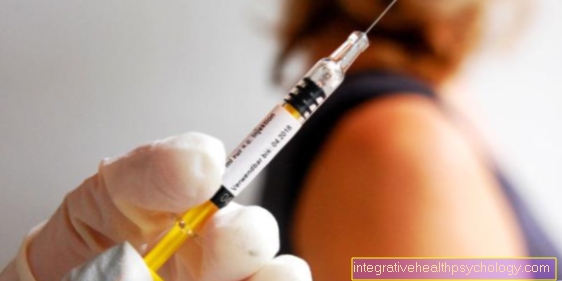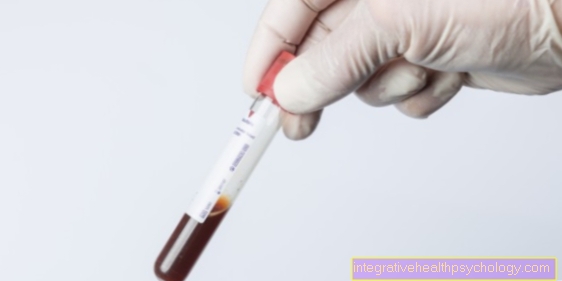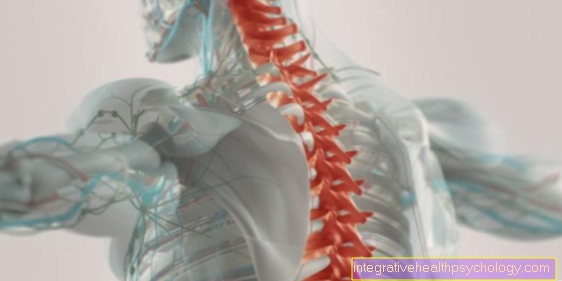Rocephin®
Active ingredient

Ceftriaxone
introduction
Rocephin® is the trade name for a drug with the active ingredient ceftriaxone, which is one of the antibiotics. A distinction is made between different groups of antibiotics, with ceftriaxone belonging to the group of cephalosporins and belonging to the third generation.
Antibiotics are generally used to kill or inhibit the growth of bacteria, so they are used to fight bacterial infections such as pneumonia (pneumonia), urinary tract infections and many others. Each antibiotic group has a particularly good effect on certain bacteria and a less good effect on others. Ceftriaxone is one of the broad spectrum or broad spectrum antibiotics, so it has a good effect against numerous germs. Ceftriaxone can only be used parenterally, i.e. bypassing the gastrointestinal tract, i.e. it cannot be used as a tablet, but only as an infusion via the vein (intravenous = i.v.) or as an injection into the muscle (intramuscular = in the.) are applied.
Side effects
All cephalosporins, including ceftriaxone, can allergic reaction trigger. First and foremost, they show up on the skin through various types of rash (Rash). Also an anaphylactic reaction to the point of anaphylactic shock is possible, this is life threatening. This is a strong overreaction of the Immune systemwhich is divided into several levels. In the beginning you may experience skin reactions such as a rash and Wheal formation show that in the course there is a feeling of heat, swallowing and breathing difficulties (Bronchospasm), nausea, Vomit and diarrhea, in the actual shock there is a significant drop in blood pressure (Hypotension) with a sharp increase in Heart rate (Tachycardia) by widening the vessels up to unconsciousness.
In contrast to allergies, the anaphylactic reaction usually occurs within a few minutes after the drug has been applied. The allergy, on the other hand, can only show itself days to weeks after the first ingestion and develops rather slowly. Furthermore, when using ceftriaxone, reversible changes in the blood count and an increase in liver values can occur, but these usually do not cause any further symptoms and are only noticeable in the laboratory values. Since ceftriaxone can only be administered intravenously, it shows less gastrointestinal side effects (nausea, vomiting, abdominal pain, diarrhea) than other active substances from its group.
With intravenous administration, inflammation of the vein (Thrombophlebitis) occur. At higher doses it can lead to Kidney damage come. In 5-10% of the cases there is a so-called cross allergy to the Penicillins. This means that if a patient cannot tolerate an antibiotic from the group of penicilins and one has to switch to another drug, this allergy can also occur with the administration of ceftriaxone, with a probability of 5-10%. Other possible side effects of Rocephin® are chills, a headache and Fungal infections in the mouth and Pubic area by killing the protective bacterial flora.
Antibiotics from the group of cephalosporins can also trigger a so-called pseudomembranous enterocolitis, inflammation of the bowel. It arises from the fact that the antibiotics inhibit or kill the resident (i.e. normally present) bacterial flora of the intestine and thus leave room for the population with the bacterium Clostridium difficile give. This disease shows up among other things by stomach pain, Diarrhea and fever. If such colitis is diagnosed, the antibiotic must be discontinued and replaced with another one that is effective against the said germs (Metronidazole or Vancomycin). Cephalosporins can rarely cause anemia (anemia) cause.
Please also read our article on this Antibiotic side effects
Interactions

Ceftriaxone and all other antibiotics from the group of cephalosporins should not be combined with antibiotics from the group of Aminoglycosides (for example Gentamycin), as this increases the risk of kidney damage significantly. Also a combination with water tablets from the group of Loop diuretics (for example Furosemide (Lasix®) should be avoided for this reason. Also a combination with antibiotics from the group of Tetracyclines such as Chloramphenicol should not be undertaken, as they mutually inhibit each other in their effectiveness.
Oral contraceptives as the pill can be limited in their effectiveness by taking antibiotics, so an additional method of contraception is advisable during the period of antibiotic intake. Furthermore, cephalosporins often lead to an incorrect determination of urine sugar within the framework of the Diabetes diagnostics, therefore inform the doctor beforehand about taking ceftriaxone. Administration of ceftriaxone at the same time as calcium-containing infusion solutions must be avoided at all costs, as this can lead to the formation of crystals with deposits in lung and kidney can come.
dosage
Adults and adolescents aged 12 and over can receive 1-2 grams of ceftriaxone once a day. The maximum dose is 4 grams. Ceftriaxone, which is available as a powder, is mixed with non-calcium-containing infusion solution to dilute the solution and infused into the vein over a period of about 30 minutes. The exact dose depends on the clinical picture to be treated. The dose in case of meningitis (meningitis) Be 100 mg per kilogram of body weight once a day, but do not exceed the maximum dose of 4 grams per day. With the uncomplicated Gonorrhea (gonorrhea) a single dose of 250 mg is usually sufficient.
Application / indications
Ceftriaxone is an antibiotic that is mostly used for severe infections. It can also only be prescribed in the hospital for the treatment of most diseases, as it usually has to be administered intravenously over several days. The areas of application include moderate to severe infections of the respiratory tract and the mouth, ear, nose and throat tract, kidney and urinary tract, including skin, soft tissue, bones and joints Wound infections, the abdomen and the sexual organs (for example Gonorrhea). It is also used to treat a sepsis (colloquially known as blood poisoning), meningitis (meningitis) and one Lyme disease, a tick-borne infection that affects the central nervous system can pass.
Contraindications
Ceftriaxone should not be used if there is a known hypersensitivity to antibiotics from the group of cephalosporins. Even with a known hypersensitivity to penicillins, caution is advised, since 5-10% of the cases lead to a Cross allergy can come.
Cephalosporins are among the antibiotics that are used during pregnancy may in principle be taken, but only if the indication is very strict.
Use should also be carefully considered during breastfeeding, as ceftriaxion can pass into breast milk and can also lead to hypersensitivity reactions in infants.
Premature babies in general and newborns with high bilirubin (Hyperbilirubinemia) must not be treated with ceftriaxone. At impaired kidney function the dose of ceftriaxone must be adjusted or completely switched to a different antibiotic.
costs
An ampoule with 2 grams of Rocephin® as a powder for the preparation of an infusion solution costs 54.53 euros.





























